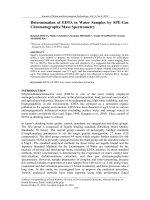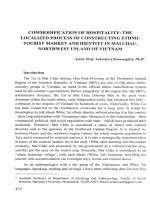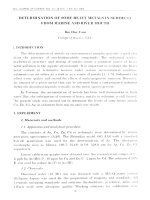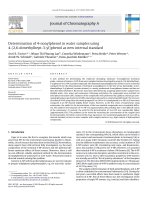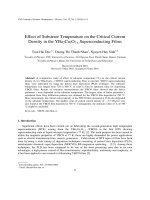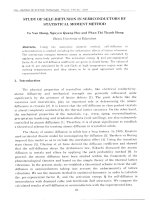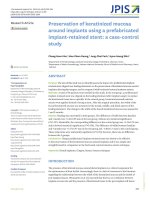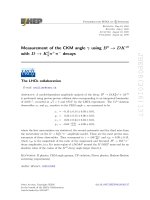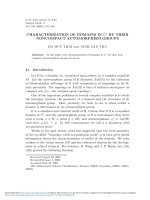DSpace at VNU: Determination of 4-nonylphenol in water samples using 4-(2,6-dimethylhept-3-yl)phenol as new internal standard
Bạn đang xem bản rút gọn của tài liệu. Xem và tải ngay bản đầy đủ của tài liệu tại đây (227.21 KB, 6 trang )
Journal of Chromatography A, 1217 (2010) 2950–2955
Contents lists available at ScienceDirect
Journal of Chromatography A
journal homepage: www.elsevier.com/locate/chroma
Determination of 4-nonylphenol in water samples using
4-(2,6-dimethylhept-3-yl)phenol as new internal standard
Axel R. Fischer a,∗ , Nham Thi Phuong Lan b , Cornelia Wiedemann a , Petra Heide a , Peter Werner a ,
Arndt W. Schmidt c , Gabriele Theumer c , Hans-Joachim Knölker c,∗∗
a
b
c
Institute of Waste Management and Contaminated Site Treatment, Technische Universität Dresden, Pratzschwitzer Str. 15, D-01796 Pirna, Germany
Hanoi University of Science, 334 Nguyen Trai, Hanoi, Viet Nam
Department of Chemistry, Technische Universität Dresden, Bergstr. 66, D-01069 Dresden, Germany
a r t i c l e
i n f o
Article history:
Received 24 November 2009
Received in revised form 18 February 2010
Accepted 24 February 2010
Available online 3 March 2010
Keywords:
Nonylphenol isomers
Internal standard
Gas chromatography–mass spectrometry
a b s t r a c t
A new method for determining the endocrine disrupting substance 4-nonylphenol (technical
grade = mixture of isomers, 4-NP) from water samples has been developed by using 4-(2,6-dimethylhept3-yl)phenol (4-sec-NP) as model compound. This branched monoalkylphenol is shown to serve as internal
standard (IS) for the determination of technical 4-nonylphenol. To the best of our knowledge, 4-(2,6dimethylhept-3-yl)phenol (racemic mixture) is a newly synthesized 4-nonylphenol isomer and has not
been described elsewhere. Recoveries have been determined by analyzing spiked water samples from
distilled water, river water and wastewater. Following acetylation, the compounds were enriched via
solid phase extraction (SPE). Analyses of the compounds were performed by capillary column gas chromatography/mass spectrometry (GC/MS), operating in selected ion-monitoring (SIM) mode. The recovery
of technical 4-NP using either the newly prepared 4-sec-NP or 4-n-nonylphenol (4-n-NP) as IS have been
compared. 4-sec-NP showed slightly better results. However, in the first series of experiments using
wastewater, the yields for the derivatization of the two standard compounds were remarkably different. The yield for derivatization of 4-n-NP was approximately 20%, probably due to the difficult matrix
of the wastewater. In contrast, the yield for the derivatization of 4-sec-NP was considerably higher
(approximately 63%). This problem can be solved by increasing the concentration of the reagent used
for derivatization. For better control of the clean-up process, we recommend application of 4-sec-NP as
internal standard, at least in water samples with complex matrices (e.g., high content of hydroxylated
compounds).
© 2010 Elsevier B.V. All rights reserved.
1. Introduction
Giger et al. were the first to recognize the hazards which may
arise from NPs for the environment and human health [1]. Meanwhile, a lot of research has been done in this field [2]. Nevertheless,
many aspects have still not been fully investigated, e.g. the exact
composition of the technical 4-NP mixture and the potential different endocrine effects of these isomers. Moreover, there is still
no cost-efficient, reliable analytical method for the determination
of nonylphenols in wastewater or river water. The present study is
directed towards solving this problem.
Isomeric 4-NP with branched alkyl groups are used in industry
to prepare alkylphenol polyethoxylates, e.g. for non-ionic surfac-
∗ Corresponding author. Tel.: +49 3501 5300 28; fax: +49 3501 5300 22.
∗∗ Corresponding author. Fax: +49 351 463 37030.
E-mail addresses: axel rene.fi (A.R. Fischer),
(H.-J. Knölker).
0021-9673/$ – see front matter © 2010 Elsevier B.V. All rights reserved.
doi:10.1016/j.chroma.2010.02.063
tants [3]. In the environment these ethoxylates are biodegraded
mainly to the corresponding NPs [4], which often can be found in
river waters and wastewater treatment plants in Germany [5,6] as
well as in many other European countries like Sweden [7]. Taking
also the different enantiomers into account, a total number of 550
4-NP isomers exist [8]. Considering only regio- and diastereoisomers, this number is reduced to 211 4-NPs. However, it is assumed
that technical 4-NP is a mixture of about 100 isomers [9]. The 4-NP
isomers are endocrine disruptors and often recalcitrant in the environment [10,11]. Due to their hazardous properties 4-NP isomers
are actually part of the “list of priority substances” of the European
Union [12]. The Directive 2003/53/EC implemented on 17th January
2005 allows application of 4-NP in additives only in concentrations
of <0.1% by mass [13].
The analytical determination of both polyethoxylates and 4-NP
is often established in environmental laboratories [14]. During the
last years, successful efforts have been made to synthesize single
isomers of 4-NP. Aim of these efforts was the investigation of the
properties of single NP isomers (e.g. toxicity) and their identifica-
A.R. Fischer et al. / J. Chromatogr. A 1217 (2010) 2950–2955
tion within the commercial mixture [15–20]. It has been shown
that biodegradation and endocrine effects are different for the single 4-nonylphenol isomers. Therefore, experiments using only the
technical mixture (4-NP) are not sufficient [8,21].
For analysis of the technical mixture (4-NP), the linear (nonbranched) isomer 4-n-NP is often used as standard [22,23].
However, structure and shape of this molecule with a linear alkyl
chain differ markedly from the isomers in the technical mixture.
The determination of 4-NP using 4-n-NP as internal standard leads
sometimes to an underestimation of the concentration of 4-NP due
to a stronger discrimination of the analyte as compared to the IS
[24]. Moreover, the possible dependency of the response factors of
4-NP and NP quantification standards on the concentration must
be taken into account as well. In conclusion, a 4-nonylphenol with
a branched alkyl chain would represent a better internal standard
for the determination of 4-NP. However, it is required that the isomer used as new IS is not contained in the technical 4-nonylphenol
mixture (4-NP). An insufficient chromatographic separation of this
branched 4-NP isomer from the isomers of the technical mixture
would also prevent its use as IS.
The highly branched 4-NP isomers often contain a tertiary carbon atom in the alkyl chain which is linked to the aromatic ring
[25–27]. Herein, we describe the synthesis of a 4-NP isomer with a
secondary alkyl side chain (4-sec-NP) and its suitability to serve
as IS for the determination of 4-NP. The new internal standard,
introduced by the present study, shows a much better cost performance than deuterated octylphenol which has been used as IS in
an alternative study [28]. Due to better chromatographic separation
phenols and alkylphenols are often derivatized, for example with
N,O-bis(trimethylsilyl)acetamide [28] or acetic anhydride prior to
the analysis [29,30]. In the present study, acetylation was chosen for
derivatization of the phenols as this represents a routine method in
our laboratory for analyzing alkyl phenols including 4-NP [31,32].
2. Materials and methods
2.1. Synthesis of the 4-sec-nonylphenol isomer
General: All reactions were carried out in dry solvents under an
argon atmosphere. Diethyl ether (Et2 O) and dichloromethane were
dried using a solvent purification system (MBraun-SPS, M. Braun
Inertgas-Systeme GmbH, Garching, Germany). Chemicals were
used as received from commercial sources. Flash chromatography:
Merck KG, Darmstadt, Germany, silica gel (0.040–0.063 mm). Melting points IA9100, Electrothermal, Essex, UK. IR spectra: Nicolet
Avatar 360 FT-IR, Thermo Fisher Scientific, Waltham, USA; in
cm−1 . NMR spectra: Bruker, Billerica, USA, DRX 500; ı in ppm, J
in Hz. Mass spectra: Finnigan MAT-95, Thermo Fisher Scientific,
Waltham, USA, ionization potential: 70 eV. Elemental analyses:
EuroEA3000, EuroVector, Milan, Italy.
1-(4-Hydroxyphenyl)-2-methylpropan-1-one was prepared
according to a literature procedure [33].
Aluminium trichloride (42.7 g, 320 mmol) and anhydrous
CH2 Cl2 (200 mL) were added to phenyl isobutyrate (24.7 g,
150 mmol) at −5 ◦ C. After standing at room temperature for 3 d,
the reaction was quenched by addition of ice water and HCl (2 M,
200 mL). The aqueous solution was extracted four times with Et2 O,
the combined organic layers were dried over sodium sulfate and
the solvent was removed. Purification of the residue by flash
chromatography (SiO2 ; petroleum ether–Et2 O, 5:1) afforded 1(4-hydroxyphenyl)-2-methylpropan-1-one as colourless oil, yield:
14.3 g (58%) (Fig. 1).
IR (ATR): = 3280, 2972, 2934, 2874, 1651, 1597, 1574, 1512,
1439, 1382, 1352, 1280, 1217, 1153, 1107, 980, 844, 762, 692,
599 cm−1 . 1 H NMR (500 MHz, CDCl3 ): ı = 1.21 (d, J = 6.8 Hz, 6 H),
2951
Fig. 1. Synthesis of 1-(4-hydroxyphenyl)-2-methylpropan-1-one.
3.56 (septett, J = 6.8 Hz, 1 H), 6.96 (d, J = 8.8 Hz, 2 H), 7.84 (br s, 1
H), 7.92 (d, J = 8.8 Hz, 2 H). 13 C NMR and DEPT (125 MHz, CDCl3 ):
ı = 19.37 (2 CH3 ), 34.99 (CH), 115.63 (2 CH), 128.33 (C), 131.14 (2
CH), 161.14 (C), 205.18 (C O). MS (EI): m/z (%) = 164 (6) [M+ ], 121
(100), 93 (9), 65 (7). HRMS: m/z [M+ ] calcd. for C10 H12 O2 : 164.0837;
found: 164.0832. Elemental analysis calcd. for C10 H12 O2 : C 73.15,
H 7.37; found: C 73.57, H 7.43.
A solution of 1-bromo-3-methylbutane (18.8 g, 120 mmol) in
Et2 O (100 mL) was added to a suspension of magnesium turnings
(3.0 g, 120 mmol) in anhydrous Et2 O (30 mL). The rate of addition
was controlled to keep the solvent boiling. After the addition was
completed, the mixture was heated at reflux for 20 min. A solution
of 1-(4-hydroxyphenyl)-2-methylpropan-1-one (8.2 g, 50 mmol) in
Et2 O (25 mL) was added at room temperature to the freshly prepared Grignard reagent and the mixture was heated at reflux for 1 h.
After cooling to room temperature, HCl (1 M) (60 mL) was added
slowly and the mixture was stirred at room temperature for 3 h.
Additional HCl (1 M) was added until the mixture was acidic. The
aqueous layer was separated and extracted three times with Et2 O.
The combined organic layers were dried over sodium sulfate and
the solvent was evaporated. Purification of the residue by flash
chromatography (SiO2 ; dichloromethane) gave a mixture of isomeric nonenylphenols as light yellow oil, yield: 10.8 g (99%).
The solution of isomeric nonenylphenols (1.0 g, 4.58 mmol) in
MeOH (20 mL) was added to a suspension of 10% palladium on
activated charcoal (100 mg) in MeOH (10 mL) and stirred under
a hydrogen atmosphere (1 atm) for 24 h. The mixture was filtered through a short pad of Celite (Et2 O) and the solvent was
evaporated. Purification of the residue by flash chromatography
(SiO2 ; petroleum ether–Et2 O, 20:1) gave a colourless oil, which
crystallised to afford 4-(2,6-dimethylhept-3-yl)phenol, colourless
crystals, yield: 930 mg (92%), m.p. 44–45 ◦ C (Fig. 2).
IR (ATR): = 3327, 3022, 2953, 2928, 2869, 1612, 1598, 1511,
1466, 1383, 1366, 1223, 1172, 825 cm−1 . 1 H NMR (500 MHz, CDCl3 ):
ı = 0.69 (d, J = 6.7 Hz, 3 H), 0.79 (d, J = 6.6 Hz, 3 H), 0.80 (d, J = 6.6 Hz,
3 H), 0.86–1.01 (m, 2 H), 0.90 (d, J = 6.7 Hz, 3 H), 1.43–1.53 (m, 2 H),
1.68–1.76 (m, 2 H), 2.15 (ddd, J = 10.7, 7.3, 4.1 Hz, 1 H), 4.59 (br s, 1
H), 6.74 (d, J = 8.5 Hz, 2 H), 6.95 (d, J = 8.5 Hz, 2 H). 13 C NMR and DEPT
(125 MHz, CDCl3 ): ı = 20.44 (CH3 ), 21.01 (CH3 ), 22.27 (CH3 ), 22.90
Fig. 2. Synthesis of 4-(2,6-dimethylhept-3-yl)phenol.
2952
A.R. Fischer et al. / J. Chromatogr. A 1217 (2010) 2950–2955
(CH3 ), 28.10 (CH), 30.66 (CH2 ), 33.50 (CH), 37.10 (CH2 ), 52.36 (CH),
114.71 (2 CH), 129.50 (2 CH), 136.96 (C), 153.35 (C). MS (EI): m/z
(%) = 220 (12) [M+ ], 177 (63), 149 (7), 121 (11), 107 (100). HRMS:
m/z [M+ ] calcd. for C15 H24 O: 220.1827; found: 220.1827. Elemental
analysis calcd. for C15 H24 O: C 81.76, H 10.98; found: C 81.67, H
11.31.
2.2. Chemicals
The water used in the experiments was purified in a reagent
grade water system (Millipore). Standards of 4-NP (technical
grade mixture) and 4-n-NP (p.a. grade) were received from
Sigma–Aldrich. Acetic anhydride, sodium hydroxide, potassium
carbonate and sodium sulfate were also p.a. grade (Merck, Germany). Prior to use, sodium sulfate was activated at 100 ◦ C for 2 h.
All solvents were purchased at p.a. grade (Merck, Germany). Stock
solutions of 4-NP, 4-n-NP and 4-sec-NP were prepared in MeOH
and stored at 4 ◦ C.
2.3. Derivatization and solid phase extraction (SPE)
For calibration experiments – from determination limit
(500 ng/L) to 33 g/L – stock solutions of technical 4-NP in distilled
water were prepared first. 4-n-NP and 4-sec-NP isomers were used
as IS. After calibration, surface water samples of the Elbe river near
Pirna, Germany, as well as wastewater samples, the influent of a
wastewater treatment plant in Saxony, Germany, have been used.
For derivatization a pH ≥ 11.0 is necessary. However, at this pH
small amounts of iron precipitated from river water and wastewater. Therefore, the filtration was carried out subsequent to the
increase of the pH value.
1 L of each water sample was poured into a brown bottle.
Afterwards, 1 mL of NaOH 32% and 25 mL of K2 CO3 (1.0 M) were
added. Stirring (500 rpm) was stopped after 10 min. Then, the water
sample was filtered through a cellulose acetate filter (0.45 m) purchased from Sartorius Stedim Biotech GmbH, Goettingen, Germany.
Afterwards, the water was spiked with a mixture of 4-sec-NP, 4-nNP and technical 4-NP. Under stirring, 1 mL of Ac2 O was injected.
The stirring was stopped for 10 min. Subsequently, the water samples (1 L volume) were applied to the cartridges at a flow rate
of approximately 25 mL/min for distilled water and river water
and 15 mL/min for wastewater. The cartridges contained 200 mg
LiChrolut RP-18 (Merck KG, Darmstadt, Germany) in the top and
100 mg LiChrolut EN in the bottom, separated by a frit. The columns
were prepared for analyses by rinsing them sequentially with 5 mL
of distilled water, 5 mL of MeOH, and with 5 mL of distilled water.
After the extraction, the cartridges were dried by a slight nitrogen
stream and eluted with 1.9 mL of acetonitrile. The extract was dried
with sodium sulfate and moved into a small brown glass vial.
2.4. Gas chromatography
An HP 6890 GC with MSD 5973 was used for analyses of NP.
The GC was equipped with a DB-5MS column, 30 m × 0.25 mm
i.d. (phenyl-arylene-polymer virtually equivalent to a (5%-phenyl)methylpolysiloxane; Agilent Technologies; made in USA) with the
film thickness of 0.25 m. The injector/autosampler (7683 Series,
Agilent Technologies) was operated in splitless mode by the front
EPC split/splitless inlet at a temperature of 250 ◦ C. The pressure inside the inlet was adjusted at 64,673 Pa and total flow of
48.6 mL/min at setpoint. The purge flow of split venting was set
at 45.0 mL/min after 2 min. Injection volume was 2 L. The washing between two sequenced sample vials was carried out for six
times by solvents (n-hexane and MeOH, respectively). The carrier
gas used was helium with a flow rate of 1 mL/min (constant pressure of 64,673 Pa) and the average velocity inside the column was
approximately 37 cm/s. Mass spectra were obtained at 70 eV and
monitored from m/z = 29 to 550 (SCAN mode). For quantification,
the selective ion-monitoring mode (SIM) has been used. The GC
oven temperature was first held at 80 ◦ C for 1 min, then increased
to 200 ◦ C at a rate of 10 K/min and kept at this temperature for
2 min. Subsequently, the temperature was increased to 300 ◦ C at a
rate of 30 K/min and then kept at this temperature for 5 min.
Concentrations of 4-NP in all water samples were calculated by
comparing the sum of the peak areas of all isomer peaks relative
to the peak areas of the internal standards 4-n-NP and 4-sec-NP,
respectively. Blanks were performed on each day of extraction.
2.5. Quantification procedure
The quantification of technical 4-NP is difficult because the composition of the mixture is unknown and peak detection of the pure
single isomers is impossible. Therefore, to avoid a superimposition
of single isomer peaks, five groups of 4-NP isomers with different
main fragments (121, 135, 149, 163 and 177) have been identified
by one peak each, which showed the best chromatographic separation. Detected masses for the internal standards were 107, 220 and
262 (4-n-NP) and 220 and 262 (4-sec-NP). Recoveries have been
determined by addition of the TIC areas of the acetyl derivatives.
These TIC areas of the single NP isomers have been determined from
the relative main fragments by using correction factors C according
to a well known published method [6]:
C=
areaTIC
areaquantification
ion
The TIC full scan areas of the isomers were calculated by analyzing both the area of the main fragments of the five 4-NP isomer
groups and the mass distribution at the top of each peak in the gas
chromatogram. This approach is based on the assumption that the
top of each peak shows the correct percentage distribution of the
relative mass spectrum.
The areas of the internal standards 4-n-NP and 4-sec-NP were
used for calculating the 4-NP concentrations by using the IS method
with the following equation:
Conctech.
NP
= Cn × Concis ×
1
An
×
Rf
Ais
+ Cn+1 × Concis ×
1
An+1
×
+ ...
Rf
Ais
where Conctech. NP is the concentration of technical 4-NP in the
samples, Cn is the correction factor for each isomer, Concis is the
concentration of the IS, Rf is the response factor, An is the area
of one main fragment of an isomer of technical 4-NP (e.g. area at
m/z = 135) and Ais is the area of the main fragment of the IS, respectively. The response factors for each concentration range have been
determined anew before each measurement.
3. Results and discussion
Fig. 3 shows a chromatogram of all isomers: technical 4-NP,
4-n-NP and the new 4-sec-NP. According to the new nomenclature system [34] the new isomer 4-sec-NP used in this
study has No. 146 (4-[1-isopropyl-4-methylpentyl]phenol = 4-[2,6dimethylhept-3-yl]phenol).
The technical 4-NP showed additional small peaks interfering
with the retention time of the 4-sec-NP isomer. These could be
either isomers of 2-NP, which are also mentioned in the commercial
description of the technical 4-NP mixture [35], or other 4-sec-NPs.
Despite the fact that these 2-isomers are only impurities in 4-NP
a disturbance of some main quantification masses could not be
excluded. Therefore, the peaks of the molecular ions at m/z = 220
A.R. Fischer et al. / J. Chromatogr. A 1217 (2010) 2950–2955
2953
Table 1
Selected properties of the used waters.
Elbe river
Wastewater
a
SAC254 [m−1 ]
Conductivity [S/cm]
Chem. O2 demand [COD, mg/L]
Biol. O2 demand [BOD5 , mg/L]
pH
a
320
1700
≤25
560
≤8
280
7.4
7.9
Approximately 20
>100
Spectral absorption coefficient at 254 nm.
Table 2
Recoveries and standard deviations (StD) of technical 4-NP with the internal standards 4-n-NP and 4-sec-NP.
Distilled water
Elbe river
Wastewater
1 mL Ac2 O
Wastewater
5 mL Ac2 O
Recovery [%] with 4-n-NP
StD [%]
n=4
125.8
95.2
184.6
5.6
4.4
32.8 (n = 8)
92.2
2.7
Fig. 3. Chromatogram of the NP isomers used in the present study.
and 262 were chosen for quantification of 4-sec-NP. Although, this
represents the molecular mass of all O-acetyl NP derivatives, only
the 4-n-NP and 4-sec-NP isomers show a detectable peak for the
molecular ion in the mass spectrum with a relative intensity of 20%
and 4.7%, respectively. Therefore, an overlap with peaks resulting
from the other isomers present in 4-NP was not to be expected.
The presence of a significant peak for the molecular ion
(m/z = 262) in the mass spectra of 4-NP isomers appears to depend
on the branching of the nonyl side chain. Considering the branching at the alpha-carbon atom of the nonyl chain, the 4-NPs are
divided into three groups: primary (–CH2 –), secondary (–CHR1 –)
and tertiary (–CR1 R2 –) derivatives [27]. Presumably, most isomers
of technical 4-NP have a tertiary alkyl side chain. The retention
Recovery [%] with 4-sec-NP
93.8
96.3
70.1
113.7
StD [%]
n=4
1.5
2.1
8.0 (n = 8)
5.2
times of 4-sec-NP and 4-n-NP are different from those of the technical mixture which indicates their different structure. Various
research groups tried to identify the structure of the isomers of
technical 4-NP. Fries and Puttmann identified four different isomer
groups using GC/MS [6]. Thiele et al. synthesized 10 isomers of 4NP [26]. Finally, Ieda et al. [25] identified in the technical mixture
12 main groups containing altogether 102 different NP isomers.
All of these authors found exclusively tertiary NP compounds. Our
assumption is based on the fact that the nonene isomers used for
industrial production of the NP ethoxylates derive from trimerization of propylene [32]. A higher degree of branching caused by a
fast catalytical rearrangement during the reaction would stabilize
the nonyl residue. In order to confirm this assumption, it would
be required to analyze all isomers of the technical mixture of 4NP. However, identification of the structures based solely on mass
spectra can be misleading. Thiele et al. [26] showed that the classification made by Wheeler et al. [27] based on analysis of the mass
spectra has not been correct in all cases.
Very recently, efforts have been made to predict the main fragments and the retention times of all 211 NP isomers for GC/MS
determination [36]. However, the present results do not confirm
these theoretical calculations, at least not for the new 4-sec-NP
with the 2,6-dimethylhept-3-yl residue in the 4-position. The mass
spectrum of 4-sec-NP shows main fragments at m/z = 107 and 177,
whereas the proposed main fragment m/z = 149 is only of little
intensity (Fig. 4). Moreover, the retention time of 4-sec-NP is not
close to the mean value observed for all 4-NP isomers. In contrast,
the retention time of 4-sec-NP is similar to the least polar 4-NP
isomers and to some 2-NPs.
The new 4-sec-NP isomer was used as IS in comparison to 4-nNP for analytical determination of technical 4-NP in water samples
with difficult matrices. Water from the Elbe river near Pirna, Germany, did not contain technical 4-NP above the determination
limit (500 ng/L). On the other hand, one wastewater sample of the
Fig. 4. Mass spectrum of 4-(2,6-dimethylhept-3-yl)phenol (4-sec-NP).
2954
A.R. Fischer et al. / J. Chromatogr. A 1217 (2010) 2950–2955
Table 3
Derivatization yields of 4-n-NP and 4-sec-NP in different waters.
Distilled water
Elbe river
Wastewater
1 mL Ac2 O
Wastewater
5 mL Ac2 O
Yield [%] of deriv. 4-n-NP
StD [%]
n=4
Yield [%] of deriv. 4-sec-NP
StD [%]
n=4
83.2
70.7
19.7
9.1
5.3
4.6 (n = 8)
86.5
84.9
63.1
9.3
3.4
4.5 (n = 8)
88.7
2.4
97.8
0.6
influent of a communal wastewater treatment plant in Saxony,
Germany, contained technical 4-NP in considerable amounts (ca.
4 g/L). Table 1 shows some properties of the used waters.
The results of the determination of 4-NP for a series of surface
water samples have been validated by addition of 4-n-NP and the
new 4-sec-NP isomer as internal standards applying the spiking
technique (Table 2).
In distilled water 4-NP was overestimated with the IS 4-n-NP.
The first results of wastewater experiments using 4-n-NP as IS were
inaccurate. The value obtained for concentration of 4-NP by this
method was almost double of the real concentration. The reason for
the wrong calibration was probably an unsuitable derivatization of
4-n-NP, presumably due to the complex matrix. The wastewater
obviously contained compounds which influenced the derivatization. Boyd proposed 2 mL Ac2 O per liter aqueous solution [29]. In
our experiments, we used 1 mL of the derivatization reagent Ac2 O
per liter (approximately 0.01 mol/L). It was observed that 4-n-NP
was derivatized only to a small extent leading to a considerable
overestimation of the amount of technical 4-NP. Technical 4-NP
and 4-sec-NP have been derivatized with a higher yield (60–70%).
For further experiments with wastewater the amount of the derivatization reagent (Ac2 O) was increased from 1 to 5 mL which had a
positive effect on the yield of derivatization. However, due to these
experiences the yields for different derivatizations have been controlled by comparison of the peak areas for both, the derivatized
and the non-derivatized internal standards. The complex calculation of the non-derivatized 4-NP fraction was not performed since
it can be roughly estimated based on the recovery. For example, a recovery of 100% of 4-NP by using 4-n-NP as IS leads to
the conclusion that both 4-NP and 4-n-NP have been derivatized
to a similar extent. Table 3 shows the yields of the derivatization for both IS (4-n-NP and 4-sec-NP) using different water
sources.
However, even in distilled water the derivatization was incomplete. To some extent, the differences in the recoveries could be
ascribed to this observation. The incomplete derivatization is only
noticeable if the yields differ significantly for different 4-NP isomers. In complex matrices, this may be the case if the reagent
used for derivatization, e.g. acetic anhydride, is at least partially
consumed by hydroxylated compounds as well as by the large
amounts of water. Depending on the structure of the alkyl chain,
the endocrine impact of each isomer is different [18,19]. Our results
confirm the influence of the structure of the nonyl residue on the
chemical behaviour.
The current guide of the European Union for the analysis of
nonylphenols recommends derivatization to get improved results
in case of poor chromatographic separation [37]. This guide refers
mainly to the work of Haller and Hansen who investigated three
different suitable reagents for the derivatization of nonylphenol
[38]. However, acetylation and methylation have not been tested
by these authors for derivatization of nonylphenol. Considering the
broad range of reagents known for derivatization of phenols, it is
likely that many research groups are still using diverse methods
for the derivatization of 4-NP. Therefore, more research directed
towards the improvement of NP analytics using 4-sec-NP as inter-
nal standard by application of different methods (with or without
derivatization) is still required.
The general problem of the quantification of 4-NP is the fact that
the amount of each isomer within the entire mixture is unknown.
The response factors for the single isomers can differ and thus lead
to inaccuracies of the calculation. Moreover, different mixtures of
technical 4-NP are being commercialized [6]. Therefore, the accurate quantification of technical 4-NP in the environment is difficult.
Moreover, it can be assumed that the different isomers of technical
4-NP are affected to a different extent by biodegradation. It has been
reported that bacteria can differentiate between some isomers of
technical 4-NP and also the estrogenic activity of the isomers is
dependent on their structure [8,21]. An approximate quantification of 4-NP can be made assuming that the response factors for
all 4-NP isomers are nearly equal and thus, the correlation of the
peak area with the concentration of each 4-NP isomer should be the
same for all isomers. Only the sharpest peaks of each 4-NP group are
detected. Therefore, quantification of isomers not providing sharp
peaks in the chromatogram is not feasible.
In order to estimate the difference between the response factors of 4-n-NP and 4-sec-NP, a solution of acetonitrile/MeOH (1:1,
100 mL) containing equal amounts (2 mg) of 4-n-NP and 4-sec-NP
was analyzed by GC–MS (SCAN mode). The relation between the
resulting peak areas was 0.715:1.00 (mean value of 10 determinations). In consequence, there is a considerable difference between
the two response factors of 4-n-NP and 4-sec-NP, which presumably applies to the response factors of other 4-NP isomers as well.
Therefore, the method widely used for the calculation of 4-NP
concentrations may lead to wrong results when applied to environmental samples.
4. Conclusions
A new method for quantitative determination of the endocrine
disruptor 4-NP in water was elaborated using 4-sec-NP as new IS.
Quantifications based on the common IS 4-n-NP did not provide
satisfactory results. Using wastewater samples, the yield for derivatization (acetylation) of 4-n-NP has been very low, presumably
due to matrix effects. As a solution of this problem, we recommend 4-sec-NP as IS for quantitative determination of 4-NP in
water samples. Moreover, alternative methods of derivatization
(e.g. silylation or methylation) should be investigated for quantitative determination of 4-NP using 4-sec-NP as IS.
Acknowledgement
We would like to thank the German Ministry of Education and
Research for financial support of this work (Project Mega Fate II,
ref. no. 10602067).
References
[1] W. Giger, P.H. Brunner, C. Schaffner, Science 225 (1984) 623.
[2] N. Lubick, Environ. Sci. Technol. 42 (2008) 6313.
A.R. Fischer et al. / J. Chromatogr. A 1217 (2010) 2950–2955
[3] T. Nakagawa, N. Sugaya, K. Sakurai, J. Nakagawa, K. Usukura, N. Onda, Anal. Sci.
Suppl. 17 (2001) i1597.
[4] M. Sekela, R. Brewer, G. Moyle, T. Tuominen, Water Sci. Technol. 39 (1999) 217.
[5] C. Hohne, W. Puttmann, Environ. Sci. Pollut. Res. Int. 15 (2008) 405.
[6] E. Fries, W. Puttmann, J. Environ. Monit. 5 (2003) 598.
[7] K. Bjorklund, A.P. Cousins, A.M. Stromvall, P.A. Malmqvist, Sci. Total Environ.
407 (2009) 4665.
[8] K. Guenther, E. Kleist, B. Thiele, Anal. Bioanal. Chem. 384 (2006) 542.
[9] F.L. Gabriel, E.J. Routledge, A. Heidlberger, D. Rentsch, K. Guenther, W. Giger,
J.P. Sumpter, H.P. Kohler, Environ. Sci. Technol. 42 (2008) 6399.
[10] N. Jonkers, R.W.P.M. Laane, C. de Graaf, P. de Voogt, Estuar. Coast. Shelf Sci. 62
(2005) 141.
[11] M. Teles, C. Gravato, M. Pacheco, M.A. Santos, Chemosphere 57 (2004) 147.
[12] G. Gatidou, N.S. Thomaidis, A.S. Stasinakis, T.D. Lekkas, J. Chromatogr. A 1138
(2007) 32.
[13] Official Journal of the European Union L 178 (2003) 24: Directive 2003/53/EC
of the European Parliament and of the Council of 18 June 2003.
[14] M. Naassner, M. Mergler, K. Wolf, I. Schuphan, J. Chromatogr. A 945 (2002) 133.
[15] T. Katase, K. Okuda, Y.S. Kim, H. Eun, H. Takada, T. Uchiyama, H. Saito, M. Makino,
Y. Fujimoto, Chemosphere 70 (2008) 1961.
[16] A.S. Russ, R. Vinken, I. Schuphan, B. Schmidt, Chemosphere 60 (2005)
1624.
[17] M.J. Telscher, U. Schuller, B. Schmidt, A. Schaffer, Environ. Sci. Technol. 39 (2005)
7896.
[18] J.O. Lalah, K.W. Schramm, G.F. Severin, D. Lenoir, B. Henkelmann, A. Behechti,
K. Guenther, A. Kettrup, Aquat. Toxicol. 62 (2003) 305.
[19] J.O. Lalah, K.W. Schramm, D. Lenoir, B. Henkelmann, N. Hertkorn, G. Matuschek,
A. Kettrup, K. Gunther, Chemistry 7 (2001) 4790.
[20] H. Shioji, S. Tsunoi, Y. Kobayashi, T. Shigemori, M. Ike, M. Fujita, Y. Miyaji, M.
Tanaka, J. Health Sci. 52 (2006) 132.
[21] F.L. Gabriel, W. Giger, K. Guenther, H.P. Kohler, Appl. Environ. Microbiol. 71
(2005) 1123.
2955
[22] R. Loos, G. Hanke, G. Umlauf, S.J. Eisenreich, Chemosphere 66 (2007) 690.
[23] R.J. Meesters, H.F. Schroder, Anal. Chem. 74 (2002) 3566.
[24] B. Kuch, Die Analytik Prioritärer Stoffe der Wasserrahmenrichtlinie, AQS
Jahrestagung, 10th March, Stuttgart, Germany, 2005 (www.iswa.unistuttgart.de/ch/aqs/pdf/JT05 Kuch.pdf).
[25] T. Ieda, Y. Horii, G. Petrick, N. Yamashita, N. Ochiai, K. Kannan, Environ. Sci.
Technol. 39 (2005) 7202.
[26] B. Thiele, V. Heinke, E. Kleist, K. Guenther, Environ. Sci. Technol. 38 (2004) 3405.
[27] T. Wheeler, J.R. Heim, M.R. LaTorre, A.B. Janes, J. Chromatogr. Sci. 35 (1997) 19.
[28] P.M. Hoai, S. Tsunoi, M. Ike, Y. Kuratani, K. Kudou, P.H. Viet, M. Fujita, M. Tanaka,
J. Chromatogr. A 1020 (2003) 161.
[29] T.J. Boyd, J. Chromatogr. A 662 (1994) 281.
[30] A.J.H. Louter, P.A. Jones, J.D. Jorritsma, J.J. Vreuls, U.A.T. Brinkman, J. High Resol.
Chromatogr. 20 (1997) 363.
[31] B.L. Tan, D.W. Hawker, J.F. Muller, L.A. Tremblay, H.F. Chapman, Water Res. 42
(2008) 404.
[32] H. Lee, T.E. Peart, Anal. Chem. 67 (1995) 1976.
[33] T.I. Briggs, G.G.S. Dutton, E. Merler, Can. J. Chem. 34 (1956) 851.
[34] K. Guenther, E. Kleist, B. Thiele, Anal. Bioanal. Chem. 384 (2006) 542, electronic
supplementary material ( />[35] B. Thiele, K. Günther, M.J. Schwuger, Chem. Rev. 97 (1997) 3247.
[36] I.G. Zenkevich, A.A. Makarov, S. Schrader, M. Moeder, J. Chromatogr. A 1216
(2009) 4097.
[37] Common implementation strategy for the water framework directive (2000/60/EC), Technical Report-2009-025, Guidance Document No.
19—Guidance on surface water chemical monitoring under the water framework directive, Annex II: Substance Guidance Sheets, nonylphenol, 44–45, ISBN
978-92-79-11297-3, ISSN 1725-1087, No. Catalogue—KH-AN-09-019-EN-N,
©European Communities.
[38] R. Haller, N. Hansen, Nonylphenols—Experimental Work Including Ruggedness
Test, Eurofins, Denmark, 2006, />Report ruggedness NP.pdf.
